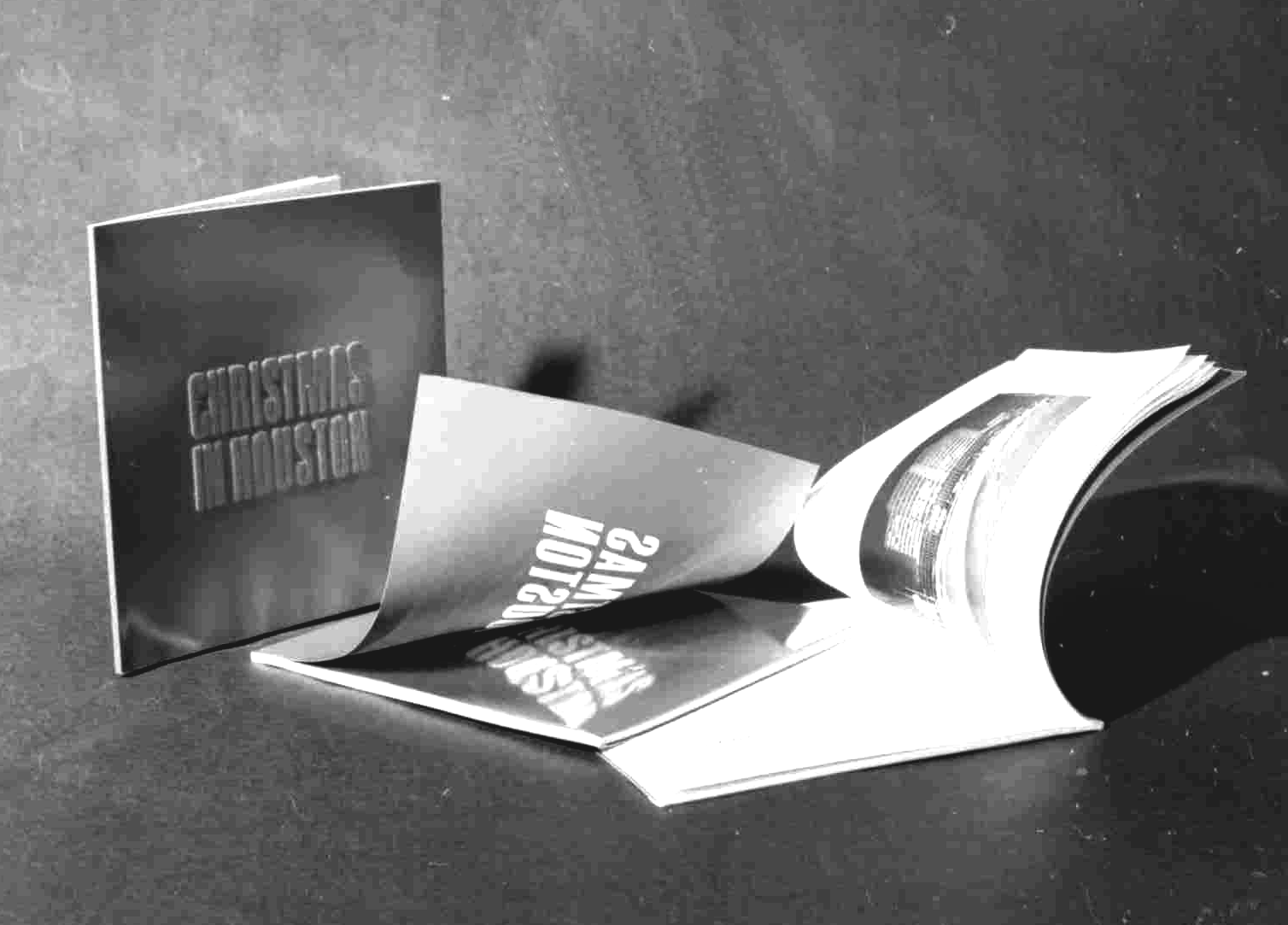Published Writings 12 - as referred to by *
(Designed in collaboration together with Don Erdman )
Don loved Graphics, had a laconic sense of humor, and we practiced together as "ArchiTex" [see project in Architecture in Greece in PUBLISHED WRITINGS 6]. . . and produced these two books for fun.



CHRISTMAS IN HOUSTON
A deadpan 'provocation' on the context of a Climate and Social context alien to traditional ideas of "Winter" and "Yule-tide". A homage to Ed Ruscha's 'little books', especially COLORED PEOPLE; our pages were printed one-sided/folded over (such as the Dutch Expressionist WENDINGEN series, and traditional Japanese books) to make the book "thicker". The book was Cited by Ada Louise Huxtable in the NYTimes 19 December 1977.

Designed in the manner of a Japanese book, printed on one side, folded to make it "thicker" in order to bind it. Note the obviously 'Christmas' colors of red + green. The first two pages combine an inverted title, which is reflected to be read by the gold-foil endpaper page.

The front cover renders the lettering of the Tite in red "flocking", a fuzzy texture used often on Christmas trees.

LEFT: the 'inversion' of the Title. RIGHT: the gold foil endpaper which reflects and permits a glimpse of the Title 'right-side-up' as the book is opened.

The 'Introduction' is an ironic critique of the urban context, the social context, and the role of buildings within the physical reality of the "new urban form".

Buildings old and new, embellished with Christmas colrs in red and green. This is one of the city's first "towers", designed by A.C.Finn (a homage to Eliel Saarinen's Chicago Tribune competition).

"Putting Christ back into Christmas".

Getting the Red and Green to pop out.

A deadpan reproduction of lights that don't quite carry the Message.

Another deadpan observation, this being the best viewing spot.

How "GREEEEEN" can you get? Even when a lightbulb may be out.

A landmark, Christmas with palm trees. Regretfully, The Shamrock is since destroyed. (see Texas Architect Nov-Dec 1979, "Doldrums in the Suburbs"; Published Writings 4)

Astrodome: the brainchild of Judge Roy Hofheinz (see PUBLISHED WRITINGS 11: AD/"The Pope and The Judge").

Another office building in bright green, with a touch of red.

Another example of alternating red and green, as if the roof was designed for the occasion.

City Hall, a 1930s Art Deco building, whose clock hands are glass with natural neon gas, which turns red.

Another example of GREEEEEEN!

Credits, an "art book" of limited production, numbered edition. The inner cover also green.

As an artist and photographer, Ed Ruscha's limited production 'books' are a deadpan look at themes, and served as our inspiration.

Similar to our Plates, the book contains deadpan "as found" images of . . . Cacti, the "Colored People" of the title. BUT: Ruscha (in order to get the thickness for "perfect-binding) simply left half the book with blank pages . . . even more deadpan.
THE MUSEUMS OF FINE ARTS
I worked with Don in ArchiTex while producing the AIA Guide 'HOUSTON an architectural guide' [see PUBLISHED WRITINGS 7 ]; as the Guide neared completion, we collaborated on producing another book, the subject of this Published Writings.

The occasion was construction of the "new" extension of the MFA,H by Mies van der Rohe. The Black color is a reference to the anticipated final appearance.

I thought about our naming the book "Six Not-So-Easy-Pieces", as the narrative will make clear.

My 'schema' again: a series of inversions/positive-negative/contrasts of matte + glossy.

Published by Rice for distribution at the 1972 AIA Convention in Houston, the first since 1949.

A discussion of "how" does one add onto or insert a "new" form in relation to a pre-existing condition?

William Ward Watkin, job captain for Ralph Adams Cram for Rice University, who remained in Houston to become first Chair of Architecture, envisioned a courtyard scheme.

Don felt we should document the evolution by a rigorous series of consistent drawings at the same scale.

As shown, "small beginnings" to bring 'cult-chah' during the Gilded Age.

Comparing the Vision by Watkin to states of evolution.

All plans were illustrated.

Vintage photos, also illustrating the nexus of the Main Street/Montrose Blvd triangular intersection, the residential Warwick Hotel, and the flat landscape of the Rice campus..

'Modern' design of the Blaffer Wing: stripped-down Classicism.

The addition created a "dead-end".

LEFT: an ambitious proposal for 'completion', embodying both a "drive-thru" dropoff (Houston Reality), 1940s Classicism. RIGHT: the trail to Mies.

With James Sweeney as the new Director, the Mies scheme was a clear open space.

The "courtyard" was reinterpreted.

Construction photos illustrated the grafting of New to Old with clear-span beams from which the roof would be 'hung'.

Entry was redefined. The transparent facade was North-facing; in the main space, Sweeney made use of 'floating' panels.

Geometry originated from the arc of Bisonnet Street and a radius from the triangular intersection. As noted, it recalls the 1930's Mies Reichsbank project in Berlin.

Spatially, the Mies Garden proposal was a demonstration of his principles, and a means of 'closing' the original Entry into a connection for the Garden.

Comparisons.

A logical extension from Cullinan Hall into the Brown Wing; donors always welcome.

Revisions.

LEFT: progressive evolution of the cross-sections. RIGHT: contrasting architectonic elements.

THE MUSEUMS OF FINE ARTS, HOUSTON was listed as Architecture at Rice #28; I had already designed KAHN #26 [see PUBLISHED WRITINGS 3] and WHAT U CAN DO #28 [see PUBLISHED WRITINGS 2]. Almost a decade later, I reviewed the building in P/A, Nov 1979, "Varied reflections in Houston" [PUBLISHED WRITINGS 9].

For the AIA Convention, HOUSTON an architectural guide [see PUBLISHED WRITINGS 7], was given to Members along with The Museums of Fine Arts, Houston, formatted as exactly the same size . . . to make the point to the skeptics who thought the guide would 'never' be published. BOTH were delivered on schedule, on time.
'CLICK' on images for Caption and to review in Sequence.







